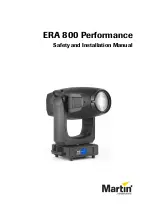
LAMBDA 10-3 OPERATION MANUAL – REV. 3.03 (20110829)
91
11.
11.
11.
11.
TROUBLESHOOTING
TROUBLESHOOTING
TROUBLESHOOTING
TROUBLESHOOTING
11.1
11.1
11.1
11.1
Filter Wheel Error Detection and Recovery
Filter Wheel Error Detection and Recovery
Filter Wheel Error Detection and Recovery
Filter Wheel Error Detection and Recovery
The LAMBDA 10
LAMBDA 10
LAMBDA 10
LAMBDA 10----3
3
3
3 contains two sensor systems that are used to monitor the actual position
of the filter wheel. After the controller sends the step sequence for a move to a new filter
position, it compares the output of these sensors with the expected position. If there is no
match, the error recovery sequence is started. First, the wheel is rotated until filter 0 is in
position. Then the unit continues to rotate at a slow rate until the correct filter is in position.
An ERROR signal is reported to the active interface.
11.2
11.2
11.2
11.2
Filter Wheel Movement Errors: Causes and Solutions
Filter Wheel Movement Errors: Causes and Solutions
Filter Wheel Movement Errors: Causes and Solutions
Filter Wheel Movement Errors: Causes and Solutions
11.2.1
11.2.1
11.2.1
11.2.1
Filter Weight vs. Speed
Filter Weight vs. Speed
Filter Weight vs. Speed
Filter Weight vs. Speed
The LAMBDA 10
LAMBDA 10
LAMBDA 10
LAMBDA 10----3
3
3
3 is optimized for the fastest exchange of two filters in research
applications. One element of the LAMBDA 10
LAMBDA 10
LAMBDA 10
LAMBDA 10----3’s
3’s
3’s
3’s overall design that contributes to its
superior performance is the acceleration and deceleration profiles that are pre-programmed
into the microprocessor commanding the motor. There is a separate profile for each
combination of
selected speed
and
number of positions to be moved
. The motor commands
produced from these profiles result in exceedingly smooth and efficient filter wheel
movements. The motor, however, is driven at its rated power which limits its ability to
overcome the inertial load of the filter wheel if the weight of the wheel is increased by
installing more (or heavier) filters. Increases in filter wheel weight, then, can lead to
movement errors unless a slower
speed setting
is selected
1
. Detection of a movement error
will initiate the RECOVERY routine described above, sending the wheel to the HOME (0)
position.
11.2.2
11.2.2
11.2.2
11.2.2
Oscillation when Stopping
Oscillation when Stopping
Oscillation when Stopping
Oscillation when Stopping
If the desired configuration of filters in your filter wheel results in a weight that is slightly
excessive for the chosen speed, the filter wheel may oscillate instead of stopping quickly when
the selected filter has rotated into position. Even though this may not be detected as an error
by the controller, it is advisable to use a slower speed. This will cause a slower acceleration
and deceleration profile to be used and, by eliminating the oscillations, may actually allow
the move to be completed more quickly.
11.2.3
11.2.3
11.2.3
11.2.3
O
O
O
Oscillations when Moving
scillations when Moving
scillations when Moving
scillations when Moving
Selecting a slower speed will generally eliminate errors caused by excessive total filter wheel
weight, but there are other considerations. For a given weight some of the slow speeds may
induce oscillations during movement. This is a result of stepping the motor near the
1
WHY NOT JUST USE A LARGER MOTOR. As the inertia increases, the force required to achieve a given acceleration and deceleration
also increases. Since the step motor in the
LAMBDA 10-C
is operated at rated power, an increase in force could only be obtained by using a
larger motor. This, in fact, is not a very satisfactory solution for the following reasons. First, larger motors have a higher
intrinsic inertia
.
Second, if the larger motor has a larger diameter it would require that the filter wheel diameter also be expanded to move the filters radially so
that the optical pathway clears the motor housing. Third, if the larger motor were longer it would increase the optical path length, which is not
desirable. At best, the net result of a larger motor might be a slight increase in speed when fully loaded, but at a cost of slowing the response
when relatively few filters are loaded.
Содержание Lambda 10-3
Страница 12: ...LAMBDA 10 3 OPERATION MANUAL REV 3 03 20110829 xii This page intentionally blank ...
Страница 46: ...LAMBDA 10 3 OPERATION MANUAL REV 3 03 20110829 34 This page intentionally blank ...
Страница 72: ...LAMBDA 10 3 OPERATION MANUAL REV 3 03 20110829 60 This page intentionally blank ...
Страница 84: ...LAMBDA 10 3 OPERATION MANUAL REV 3 03 20110829 72 This page intentionally blank ...
Страница 96: ...LAMBDA 10 3 OPERATION MANUAL REV 3 03 20110829 84 This page intentionally blank ...
Страница 102: ...LAMBDA 10 3 OPERATION MANUAL REV 3 03 20110829 90 This page intentionally blank ...
Страница 106: ...LAMBDA 10 3 OPERATION MANUAL REV 3 03 20110829 94 This page intentionally blank ...
Страница 108: ...LAMBDA 10 3 OPERATION MANUAL REV 3 03 20110829 96 This page intentionally blank ...
Страница 112: ...LAMBDA 10 3 OPERATION MANUAL REV 3 03 20110829 100 This page intentionally blank ...
Страница 128: ...LAMBDA 10 3 OPERATION MANUAL REV 3 03 20110829 116 This page intentionally blank ...
Страница 132: ...LAMBDA 10 3 OPERATION MANUAL REV 3 03 20110829 120 NOTES NOTES NOTES NOTES ...
















































